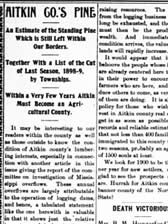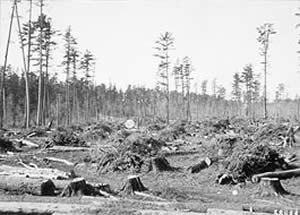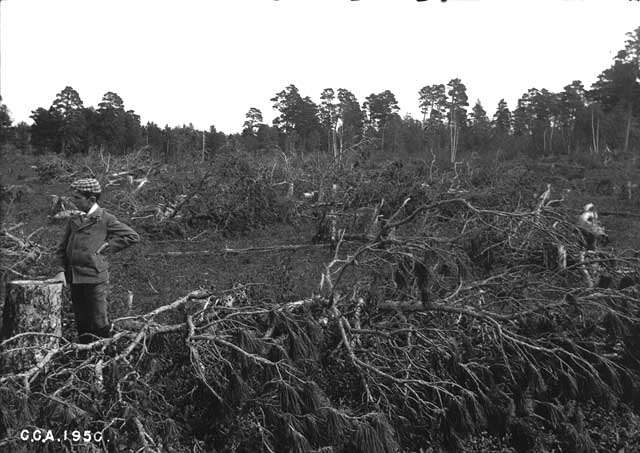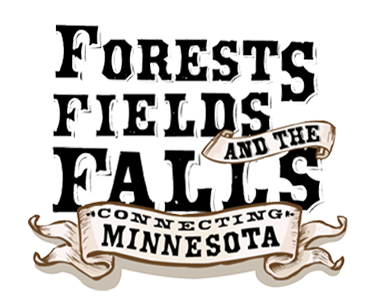In 20 More Years, Minnesota's Giant White Pine Forest Would Be Entirely Cut
"...The Standing Pine Which Is Still Left..."

Aitkin Age, December 9, 1899, p. 1
Minnesota Historical Society Newspaper Collection
AITKIN CO.'S PINE
An Estimate of the Standing Pine
Which is Still Left Within
Our Borders.
Together With a List of the Cut
of Last Season, 1898-9,
by Townships.
Within a Very Few Years Aitkin
Must Become an
Agriculture County.
It may be interesting to our readers within the county as well as those outside to know the condition of Aitkin county's lumbering interests, especially in connection with another article in this issue giving the report of the committee on investigation of Mississippi overflows. These annual overflows are largely attributable to the operation of logging dams, and hence, a tabulated statement like the one herewith is valuable in that it shows just the relative importance of the logging interests and the interests of the farmers.
…
It may be news also that there is pine still standing in Aitkin county to the extent of nearly or quite 200,000,000 feet, especially to those who never get out of Aitkin except by rail. This is apparently a fact, however, as the table below shows and aggregate of 159,700,000, while the towns from which we have been unable to get a report would no doubt swell the total to the figures mentioned above.
But if the rate of decrease keeps up to the figures of last year, it will take but four or five years to clean up all the pine in Aitkin county, and it must be remembered that much that is left is so scattered as to make profitable logging therein impracticable, and consequently some of it will not be touched for years.
…
Already large tracts in the county are stripped of pine entirely, and it is very easy to see that in the near future Aitkin county must depend upon the development of its splendid agricultural and stock raising resources. The revenue from the logging business will ere long be exhausted, and the farmer must then be the producer of wealth. And immediately this condition arrives, the value of farm lands will rapidly increase.
It would appear that it would behoove the people whose interests are already centered here to do all in their power to encourage farmers who are here, and to induce others to come, as very many of them are doing. It is also good policy for those who wish to invest in Aitkin county real estate to get in as soon as possible. The records and reliable estimates show that not less than 400 families have immigrated to this county the past two seasons, probably an aggregate of 1500 souls at least.
We look for 1900 to be the banner year for new settlers, and are glad to see the prospects as they are. Hurrah for Aitkin county, the banner county of the North Star State!
Why Was All the Pine Logged?

Minnesota Historical Society Photograph Collection
"...if the rate of decrease keeps up to the figures of last year, it will take but four or five years to clean up all the pine in Aitkin county.... Already large tracts in the county are stripped of pine entirely, and it is very easy to see that .... the revenue from the logging business will ere long be exhausted...."
—The Aitkin Age, Dec. 9, 1899
By 1920 no loggable white pine remained in the Mississippi River basin. By 1934 the great North Woods were finished. Lumbering remains a major industry in Minnesota, but it is almost entirely smaller second-growth trees being harvested for products other than construction lumber. Why?
Technology
"Seventy mills in seventy years couldn't exhaust the white pine I have seen...."
—Daniel Stanchfield, 1847
When Stanchfield made this estimate a standard sawmill could cut around 5,000 feet of lumber each day. New technologies in cutting gradually sped that up to 700,000 feet each day. Lumber camps grew to fulfill the demand, rapidly outpacing the rate Stanchfield had imagined.
Money
To keep up with the low cost and high volume of lumber made by its competitors, a mill had to upgrade its machinery to be more efficient. This cost money which would be repaid by working the mill to its full capacity. Which meant that more trees had to be cut.
Also, at the peak of the industry, giant lumber companies owned or leased most of the white pine forests. They had to pay rents or property taxes on land as long as they used it. If they cut quickly they could save the expense by either ending the lease or selling the land.
Demand
The state of Minnesota, railroads, lumber companies, and other groups advertised to attract more people to Minnesota. As the population grew, so did the need for houses, grain elevators, railroad lines, stores, tools, and other wooden goods here and in surrounding areas. White pine lumber could always be sold, no matter how much was cut.
Willingness
The big bosses of the lumber industry came to Minnesota from Maine and Michigan after having cut those forests clear. They knew early on that Minnesota's forest could also be exhausted, and yet they cut at ever-increasing rates. But there were always the forests of Idaho, Washington, Oregon, Georgia, Alabama....
And as time passed and the residents of the forest counties could foresee the impending emptiness, they often also fought conservation. They wanted the wild forests cleared so that farmers could settle it. But cutover land still had thousands of stumps to be removed and was not necessarily good for growing crops.
For more information, see Agnes Larson's History of the White Pine Industry in Minnesota.
What Happened When the Pine Was Gone?

Boy viewing pine slashing on southeast shore of Cass Lake, 1900.
Minnesota Historical Society Photograph Collection Location no. Collection I.99.73
Within one generation, more than one-third of Minnesota's total land area (including forest and prairie) was reduced to stumps and dried branches. What were the effects?
Ecological
The balance of the forest ecosystem was thrown off so that animals and other plants that had once thrived there moved out or died. Other populations moved in and further changed the system. White-tailed deer followed logging in growing numbers, eating any young white pine that tried to regrow.
When the plant and root systems that had held soil in place were removed, the land lost valuable topsoil.
The remaining stumps and dried-out waste wood (e.g. tops of trees and branches) became fuel for giant forest fires that raged through the region from the 1890s to 1920, killing humans, animals, and plants, and leaving thousands of acres charred. Fires have always been part of the forest's history, but the large amounts of fuel caused much hotter fires that burned and sterilized the topsoil.
Jobs
On the human side, the decline of logging left large numbers of people who had been dependent on the lumber industry without jobs. In 1900, one-third of the state's workforce (about 40,000 people) worked in Minnesota's forest products industry. The earnings of these 40,000 supported more than 100,000 Minnesotans. When the camps and mills closed, they had to find other work or move.
Conservation
When a farmer couldn't make a cutover field productive, the family often abandoned the land. When the property taxes weren't paid, the county or the state would gain control. These forfeited lands became a foundation for today's public forests.
As the consequences of the clear-cut logging became obvious, a conservation movement grew and had some successes. Most apparent today are the development of the system of State Parks and Forests. In 1891, conservationists won a bitter battle with lumber interests to protect the area at the headwaters of the Mississippi River, establishing the first state park at Itasca. In 1902 the Minnesota Forest Reserve protected 225,000 acres of forest now called the Chippewa National Forest.
For more information, see Agnes Larson's History of the White Pine Industry in Minnesota.

